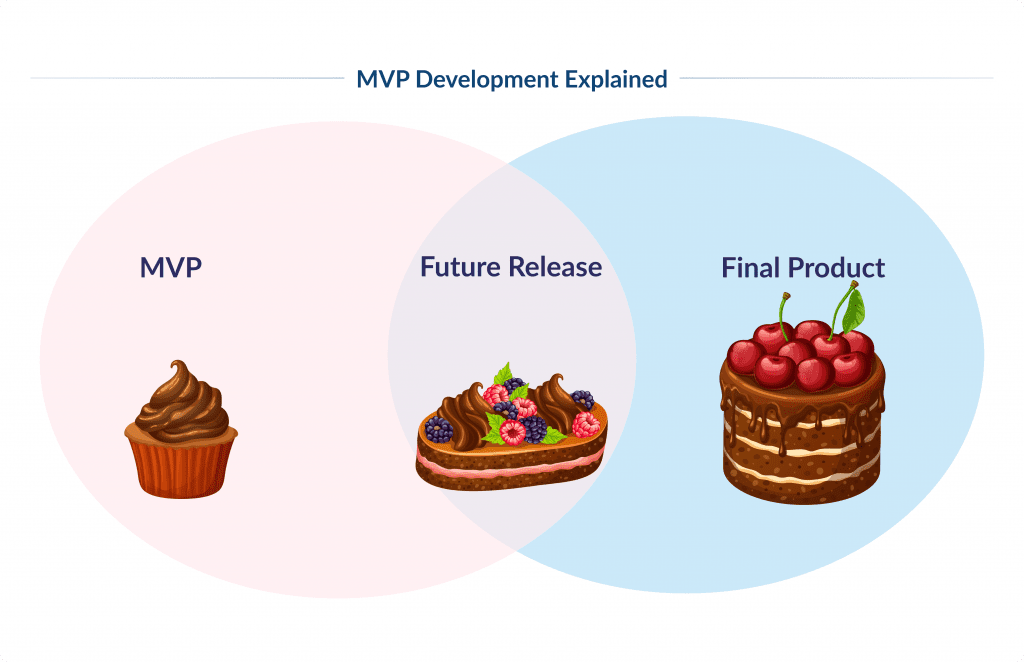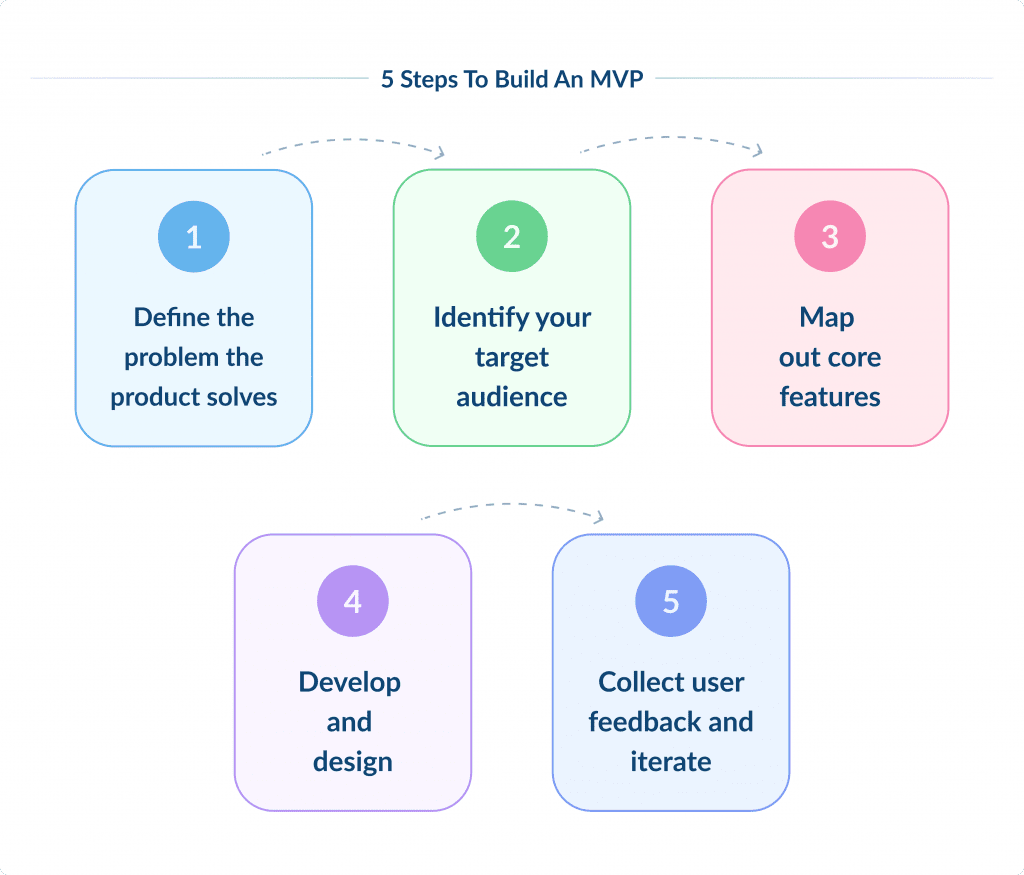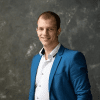MVP in Software Development: Step-by-Step Guide
- Updated: Aug 27, 2024
- 10 min
An MVP, or minimum viable product, is a term often heard in the business and startup world. Even those not directly involved in product development know about MVP.
An MVP software development concept is a key strategy for startups because it allows them to introduce their product to the public, gain an audience, reduce costs, and attract investors.
So, what is MVP in software development, and why does it matter?
Startups face a high failure rate, with up to 90% not making it. About 10% of startups fail within their first year, and up to 70% don’t survive between their second and fifth years. The main reasons for these failures include:
- Misunderstood or under-researched market needs (about 40%)
- Running out of money (30%)
- Stronger competitors (20%)
- Problems with marketing, pricing, and design (10%)
MVP development services can help startups avoid these pitfalls and successfully launch their projects. For example, Dropbox started as an MVP with a simple video explaining its concept. This approach helped gauge interest and gather feedback before full-scale development.
Another example is Zappos, which tested its idea by posting photos of shoes online to see if people would buy them before investing in inventory.
In this article, we’ll explore what a minimum viable product is and provide guidance on the entire MVP development process, giving you a behind-the-scenes look.
Need a reliable development team? Here’s your step-by-step guide to hiring a dedicated team in Ukraine.
Get a strategic MVP to mitigate risks.
What is Minimum Viable Product in Software Development?
An MVP in business is the most basic version of a product that is functional enough to be released to early users.
It includes only the essential features needed to solve a problem or meet a need. This approach helps to validate the product idea and ensure that resources are not wasted on features that users do not want or need.
A study by the Product Development and Management Association (PDMA) indicates that MVPs are critical in the product development process, significantly improving the chances of product success. 
Benefits of an MVP:
- Reduces development costs: Focusing only on core functionalities significantly reduces the software development cost and time.
- Validates market demand: Helps to validate whether there is a market need for the software product.
- Attracts early adopters and investors: Early versions can attract initial users and investors who see the potential in the idea.
Overall, successful MVP software development helps startups navigate the early stages of product development more effectively.
It minimizes risks and maximizes the chances of creating a profitable and impactful product.
Key MVP Characteristics
A Minimum Viable Product lets startups test their ideas fast and cheap. Here are the key features that make an MVP part of the development process.
Focus On Core Functions
MVP has only the features needed to solve the main problem or meet the core needs of the audience.
This helps to validate the product idea without unnecessary complexity.
Early Feedback
MVP is released to a small audience to get feedback.
This feedback is used to understand user needs and preferences and make informed decisions about future development.
Iterative Development
MVP is an iterative process.
Based on user feedback, the product is improved and expanded in subsequent versions. This way, the product is refined to meet user expectations and market demand.
Find out how long it really takes to develop an app with our comprehensive guide on how long it takes to develop an app.
Cost And Time Efficiency
According to Failory, 70% of startups fail within 2 to 5 years, often because of running out of cash or competition. An MVP helps to manage resources and adapt to the market faster.
By focusing on the most important features, MVP reduces the time and cost of further development.
This way, startups can test their idea in the market without big financial risk.
Market Validation
MVP validates the product’s market. It ensures there is demand for the product before investing in full development.
Scalability
MVP is designed to be scalable.
Once the core functionality is validated and user feedback is incorporated, additional features can be added to scale the product to meet the broader market. 
MVP Software Development Vs. PoC Vs. Prototype
Building a product often involves multiple stages, each with its own purpose and approach.
You need to understand the difference between a Minimum Viable Product (MVP), Proof of Concept (PoC), and Prototype.
An MVP is a fully working product with only the bare essentials.
Its main goal is to validate the product idea with real users and test market demand.
For example, Spotify launched as an invite-only app with basic features like music streaming. MVP allowed them to get user feedback and add more features based on that feedback.
On the other hand, a PoC is a small project to test if a specific concept or technology can be implemented.
Not for user release, but an internal validation tool. For example, a team developing a new blockchain-based payment system might create a PoC to test the security and efficiency of their proposed method before committing to full production.
A prototype is an early version of the product to visualize and test the design and functionality.
There are many types of prototypes, from simple sketches to interactive digital models, but they are not fully working products.
They help teams to explore design and user interactions.
At different stages of the product development, each is important to reduce risks and make sure the final product meets the user’s needs.
Want to launch the next Spotify? Here’s how to create a music streaming app that rocks.
MVP, Proof of Concept (PoC), and Prototype | |||
| Aspect | MVP | Proof of Concept | Prototype |
| Purpose | Validate product ideas and market demand with real users | Demonstrate the feasibility of a specific concept or technology | Visualize and test the design and user interactions |
| Scope | Core features necessary to solve the primary problem | Focused on proving a specific aspect of the project | Simulates look and feel, may not include full functionality |
| Audience | Early adopters and real users | Internal team and stakeholders | Internal team and selected users for feedback |
| Development stage | Early stages, post-concept validation | Pre-development, concept validation | Pre-development, design exploration |
| Functionality | Fully functional with essential features | Limited functionality, just enough to prove the feasibility | Varies, from non-functional mockups to interactive models |
| Outcome | User feedback for iteration and market validation | Decision on whether the concept is viable | Insights into design usability and functionality |
| Time and Cost | Moderate to high, depending on the complexity of core features | Low to moderate, focused on a specific aspect | Low to moderate, focused on, requires user experience services |
How To Build An MVP?
Now, let’s move on to the step-by-step MVP in software development.
Here are 5 steps to build an MVP for our clients.
Define The Problem
We start off MVP development by identifying the problem the product solves. It is a crucial step that, when neglected, can lead to business failure.
Before starting MVP software development, we are working with the client team to conduct market research and define a strong value proposition that includes three key elements:
- A specific audience with a specific need.
- How will your product address that need?
- The benefits the audience will gain.
Check out MVP tools for more insights.
To achieve this, we gather insights through thorough research, which typically includes:
- Market research: Analyze the market size and trends and identify target customer demographics, preferences, and pain points (Explore the most important application development trends for your business.).
- Customer interviews and surveys: Directly ask potential users about their challenges, needs, and opinions on existing solutions.
- Focus Groups: Understand how real people interact with your product concept. Explore their user stories, needs, expectations, and first impressions. Gather honest feedback through discussions with a small, diverse group of potential customers.
- Online Polls and Social Media Engagement. We use these sources to gather feedback on public interest and trends related to your product idea.
Then, we move on to the target audience analysis.
Identify Your Target Audience
My product is great for everyone! I target all people around the world!
This is something you will never hear when building an MVP, simply because you can’t target everyone.
That is why we narrow down the core audience, identifying their needs, problems, buying capabilities, interests, and other features.
All this data will help us create a product that people will more likely buy.
The result of this stage is a portrait of your average product consumer.
Map Out Core Features
Before starting actual development, we identify the main features that will form the core of the client’s minimum viable product.
We create a list of essential features and prioritize them.
An MVP typically includes only the most necessary functions, serving as the backbone of your product.
We clearly define these core features and make a list of additional features to be added later.
This approach ensures you focus on what’s crucial while keeping room for future improvements.
Think of MVP development like baking. First, you make a cupcake. This cupcake is your MVP—simple but complete and enjoyable on its own.
Next, you bake a regular cake, adding more layers and decoration based on feedback from the cupcake.
Finally, you create the wedding cake, a fully developed product with all the desired features and designs.
You test and improve each stage by starting small and building up, ensuring the final product meets everyone’s expectations. 
Development And Design
During this stage of MVP development, the goal is to build and create the essential features identified earlier.
This starts with user interface design services. Designers create a simple and intuitive user interface that provides a good experience with just the necessary functionalities.
Developers then focus on implementing these core features to ensure they work well and meet the primary needs of the target audience.
It’s important to ensure the product is easy to use and navigate, so usability testing is conducted to spot any issues.
Feedback from this testing helps identify bugs and areas for improvement. The development process remains flexible, allowing for adjustments based on user feedback and testing results.
Check out these five usability testing ways that will help elevate your startup’s performance.
This way, the MVP can evolve to better meet user needs while staying focused on its core purpose.
Whether you’re a startup or a seasoned pro, this guide on MVP design will save you time and money.
Collect User Feedback And Iterate
Once all the essential elements of the product are developed and tested by professional testers, it is time to launch it to the selected number of users.
For example, you can label features as ‘beta’ on your screens and encourage user feedback through visible mechanisms like a feedback button. Besides in-app surveys, you can also gather feedback on social media and via direct emails.
It is recommended that users use free-form surveys, in which they can share which features they dislike and suggest ones they want instead. Responding to this feedback builds trust and loyalty among early adopters.
Analytics tools are also helpful. They track user behavior and engagement, providing insights into how users interact with your MVP and guiding its development. Check out more tools to develop an MVP in our recent article. 
What’s The Average Cost Of Developing An MVP?
Now that we’ve looked at MVP software development, let’s talk about the cost and time it takes to build an MVP.
At SpdLoad, we work with clients across various industries. Here we’ll answer the question “How much does an MVP cost?” using our approach.
Estimating MVP Development Cost
The cost of developing an MVP can vary significantly based on the project complexity, location of the development team, and features required.
The costs vary from $10,000 to $50,000 and more. For example, $15,000 for a basic MVP and $50,000 for an advanced MVP.
Use our app development calculator to estimate app cost.
Factors Influencing MVP Software Development Cost
- Features complexity. Simple MVPs cost less, while complex ones with advanced functionalities increase the budget.
- Development team location. Hiring a team in a region with lower living costs, such as Eastern Europe or Asia, can be more cost-effective. To learn more about top IT outsourcing destinations, check out this article, where we outline the 10 best countries to outsource software development.
- Design and user interface. Investing in a well-designed, user-friendly interface is crucial for user engagement and can affect the overall cost.
- Development time. The duration of the development process directly impacts the cost. Efficient project management helps keep timelines and costs in check.
- Technology stack. The choice of technology and tools used can influence the cost, especially if specialized skills are required.
- Additional services. Project management, lean startup methodology, quality assurance, and post-launch support also contribute to the overall cost.
Check out the full MVP development pricing breakdown.
Typically, the project duration from the product discovery phase to release is about three to six months, considering one back-end and one front-end developer.
We also include a QA engineer, UI/UX designer, and project manager in our estimations.
They support steady day-to-day work and ensure quality throughout the product development lifecycle. In this way, our team and the client are able to communicate effectively.
How SpdLoad Approaches MVP Software Development
MVP web development can be intimidating for startups. Especially those without prior experience or a dedicated development team.
SpdLoad can be your MVP development partner to turn your vision into reality.
Our team utilizes an agile discovery process to build numerous successful products for our clients. We always ensure a streamlined and iterative development process.
Feel free to check out our case studies to explore our collaboration approach.
We specialize in creating MVPs within three to six months, helping you quickly bring your product to market.
Our approach relies on years of expertise to guide you to the optimal path. With well-executed MVPs, we’ve helped clients turn their products into six-figure businesses.
When you choose SpdLoad, you partner with a team dedicated to your success. Our services include both development and strategic advice. Using this method, we ensure you are able to make a significant impact with your MVP and attract early adopters.
Whether you’re looking to validate a new concept or streamline an existing one, we have the skills and experience to help you achieve your goals.
Ready to collaborate? Contact us to discuss your project.













